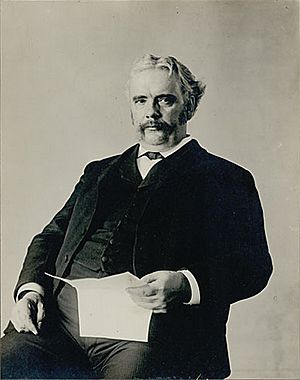William John McGee facts for kids
Quick facts for kids
William John McGee
|
|
|---|---|

McGee in 1900
|
|
| Born | April 17, 1853 Farley, Iowa, United States
|
| Died | September 4, 1912 (aged 59) Washington, DC, U.S.
|
| Nationality | American |
| Spouse(s) |
Anita Newcomb McGee
(m. 1888) |
| Children | 3 |
| Scientific career | |
| Fields | Geology, anthropology, and ethnology |
William John McGee (born April 17, 1853 – died September 4, 1912) was an amazing American scientist. He was an inventor, a geologist (someone who studies Earth's rocks and land), an anthropologist (someone who studies human societies and cultures), and an ethnologist (someone who studies different groups of people and their cultures). He was born in Farley, Iowa.
Contents
Early Life & Discoveries
William John McGee was mostly self-taught, which means he learned a lot on his own. He went to a small one-room schoolhouse near Farley for a few months each winter when he was young.
He spent his early years learning about law and how to survey land. He also created and patented several new and better tools for farming. This showed he was very clever and good at inventing things!
Exploring Earth's Secrets
Later, McGee became very interested in geology. From 1877 to 1881, he mapped and studied the land in a huge area of northeastern Iowa. This area was about 17,000 square miles!
He also studied the "loess" (a type of fine soil) in the Mississippi Valley. He researched large ancient lakes in Nevada and California. Plus, he looked at recent fault movements in the middle of the Atlantic slope.
Working for the Government
In 1881, McGee was chosen to be a geologist for the United States Geological Survey (USGS). This is a government agency that studies the Earth.
While at the USGS, he wrote an important article in 1884. It was called Map of the United States exhibiting the present status of knowledge relating to the areal distribution of geologic groups.
Studying Earthquakes
In 1886, McGee traveled to Charleston, South Carolina. He went there to study the earthquakes that had happened in that area. This helped scientists understand more about how earthquakes work.
Leading Anthropology Research
From 1893 to 1903, McGee was in charge of the Bureau of American Ethnology. This bureau studied Native American cultures.
In 1895, he explored Tiburón Island in the Gulf of California. This island was home to the Seri Indians. He learned a lot about their way of life.
In 1904, he led the anthropology department for the "Anthropology Days" at the 1904 Summer Olympics and the World's Fair. This event showcased different cultures from around the world.
Important Roles and Contributions
In 1907, President Roosevelt appointed McGee to the Inland Waterways Commission. This group worked on managing America's rivers and waterways.
McGee held many other important positions:
- He was the acting president of the American Association for the Advancement of Science from 1897 to 1898.
- He was the president of the American Anthropological Association from 1902 to 1912.
- He was also the president of the National Geographic Society from 1904 to 1905.
He was also one of the people who helped start the Geological Society of America. He was the very first editor of their magazine, The Geological Society of America Bulletin, starting in 1890.
Family Life and Legacy
William John McGee married Anita Newcomb McGee in 1888. They had three children together.
He passed away in Washington, DC on September 4, 1912.
To honor his amazing work, a mountain in California was named after him: Mount McGee.
Works
Here are some of the books and papers William John McGee wrote:
- The Pleistocene History of Northeastern Iowa (1889)
- The Geology of Chesapeake Bay (1888)
- The Seri Indians (1899)
- Soil Erosion (1911)

